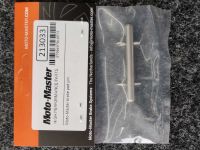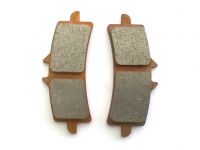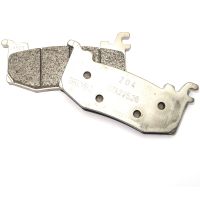Motorcycle brake pads - Sinter & Carbon with ABE
Whether your vehicle is a motorcycle or a scooter, both types of vehicle require care and attention. Especially the brakes and therefore the brake pads should be checked regularly. If a replacement is necessary, the TecBike Shop offers you a wide range of brake pads for the road and race track:
t- AP Racing brake pads
t- GL Racing brake pads for BMW
t- Brake pads Racing for Brembo calipers
t- GL brake pads Racing for Yamaha
What types of brake pads are available?
Basically we distinguish between two types of brake pads:
t- Organic pads and
t- Sintered metal coverings
Metals provide the required coefficient of friction in both linings. The necessary braking stability is ensured by high-performance and suitable lubricants.
The sintered linings
They consist of metal powder and are joined together without adhesives by a so-called sintering process: The components are pressed under high pressure and high temperatures. Experts refer to this as sintering.
The metal powders used determine the coefficient of friction and thus have a direct effect on braking behaviour. As mentioned above, lubricants are added to the basic mixture. This allows even and jerk-free braking even under extreme conditions. To keep the brake discs clean and to remove the abrasion from the braking surfaces, abrasives are used.
Sintered metal pads are characterized by a strong bite and they pack earlier compared to their organic relatives. Therefore they are preferred by many sporty drivers and are the first choice on the race track.
Organic rubbers
In the category of organic surfaces all products are summarized which are not sintered. Carbon ceramic and Carbon Tech brake pads are also included here. The most important element of these pads is the binding resin. Like the sintered versions, organic pads also contain lubricants and abrasives. This is to achieve the positive effects from which drivers of sintered metal pads benefit.
The sintered metal variants are said to be associated with higher wear. The load on the brake discs is also said to be higher compared to organic pads.
If organic pads are cold, special care should be taken when decelerating. They delay noticeably less than sintered pads. Even when wet, sintered products have a clear advantage.
If you are planning to change from organic to sintered pads, a bit of tact is required: your brakes require more dosage when decelerating due to the significantly increased bite. In practice this means: Not to pull/push the brakes as usual.
The advantages and disadvantages of both variants summarized once again
The advantages of organic brake pads
t- Cheap and simple production, therefore usually lower price
t- Unproblematic braking behaviour, even for beginners
The disadvantages
t- In the wet: Slightly lower braking effect depending on model
t- Braking" is absolutely necessary: The first 100 km or so should only be braked slowly. This is the only way to ensure that the pads adapt to the brake disks and are in full contact with them. Otherwise the pads are in danger of "glazing" and must be replaced immediately.
The advantages of sintered facings
t- High braking effect, even in wet conditions
t- High friction coefficient of the linings, less manual force required and better dosing
t- High heat resistance: Even under extreme load there is virtually no fading/lossing of the braking effect
The disadvantages
t- Sintered metal pads do not harmonize with every brake disc.
t- In some cases there is higher wear.
t- The higher heat development lets the brake fluid age faster.
t- During longer standstill periods, the pads can start to rust due to the high metal content. This applies especially during the winter break with cold and wet weather.
t- Higher price
Do brake pads have to be checked regularly and how do you do that?
When you apply the brake, the brake discs and pads rub against each other. They are thus subject to system-related and completely normal wear. Therefore we answer the question with a definite yes.
Your personal driving style and braking habits as well as the pads and brake discs used influence the degree of wear. Therefore a reliable question, when and how often you have to change the pads, cannot be answered.
If you discover during braking that the necessary braking power is no longer being provided, there is a definite need for action. For your safety, however, you should not let it go that far.
How to check the pads correctly
Regular visual inspection of the brake pads is essential for your driving safety. However, you should not be satisfied with just looking at the pads from above.
A faulty position in the brake caliper can lead to oblique wear, for example. If you only look at it from one side, this may not be visible. Therefore a lateral control and a close look from below are essential.
Very often these wear parts have a groove. Some manufacturers also equip them with several. It shows you the wear limit. At the latest when the groove is no longer visible, a change is necessary.
A look in the manual of your motorcycle will also tell you the minimum thickness of the pads required. If the lever travel of the brake valve increases or the pressure point shifts, this is also an indication of worn pads.
How to change brake pads on a motorcycle?
The most important thing to do when changing the brake pads first:
t- The change is always carried out in pairs and wheels!
t- Never use brake pads of different age or thickness. Also avoid using different manufacturers at the same time.
t- Usually one set per disc consists of two pieces. In a few exceptional cases, one brake pad is installed per brake piston. Up to six pieces per brake calliper can be combined.
t- Are there perforated Teflon or steel plates/discs on the back of the old models? Then you have to reattach them in the same position on the new pads after cleaning. They absorb some of the heat during braking and keep it away from the brake fluids and the brake pistons.
No matter what bike you own, the basic process of changing AP Racing brake pads, for example, is similar:
t- First, you take off the caliper.
t- Then remove the old pads.
t- Clean the caliper and check all components thoroughly.
t- Install the new pads for your brakes.
t- Finally, replace the brake caliper.
t- Always safe on the road - high-quality pads for the race track and the road
TecBike offers you the right pad compound for every use. Racing compounds have a very high coefficient of friction at high temperatures. Only when they have reached their operating temperatures of approx. 350 to 450 °C do they function optimally. Surfaces for the race track are not approved for the road and therefore do not have an ABE.
Compounds for road use are developed so that they work best at low to medium temperatures, such as 300°C. In the TecBike Shop you can get this version with ABE in different versions.
Motorcycle brake pads - Sinter & Carbon with ABE Whether your vehicle is a motorcycle or a scooter, both types of vehicle require care and attention. Especially the brakes and therefore the...
read more » Close window Motorcycle brake pads - Sinter & Carbon with ABE
Whether your vehicle is a motorcycle or a scooter, both types of vehicle require care and attention. Especially the brakes and therefore the brake pads should be checked regularly. If a replacement is necessary, the TecBike Shop offers you a wide range of brake pads for the road and race track:
t- AP Racing brake pads
t- GL Racing brake pads for BMW
t- Brake pads Racing for Brembo calipers
t- GL brake pads Racing for Yamaha
What types of brake pads are available?
Basically we distinguish between two types of brake pads:
t- Organic pads and
t- Sintered metal coverings
Metals provide the required coefficient of friction in both linings. The necessary braking stability is ensured by high-performance and suitable lubricants.
The sintered linings
They consist of metal powder and are joined together without adhesives by a so-called sintering process: The components are pressed under high pressure and high temperatures. Experts refer to this as sintering.
The metal powders used determine the coefficient of friction and thus have a direct effect on braking behaviour. As mentioned above, lubricants are added to the basic mixture. This allows even and jerk-free braking even under extreme conditions. To keep the brake discs clean and to remove the abrasion from the braking surfaces, abrasives are used.
Sintered metal pads are characterized by a strong bite and they pack earlier compared to their organic relatives. Therefore they are preferred by many sporty drivers and are the first choice on the race track.
Organic rubbers
In the category of organic surfaces all products are summarized which are not sintered. Carbon ceramic and Carbon Tech brake pads are also included here. The most important element of these pads is the binding resin. Like the sintered versions, organic pads also contain lubricants and abrasives. This is to achieve the positive effects from which drivers of sintered metal pads benefit.
The sintered metal variants are said to be associated with higher wear. The load on the brake discs is also said to be higher compared to organic pads.
If organic pads are cold, special care should be taken when decelerating. They delay noticeably less than sintered pads. Even when wet, sintered products have a clear advantage.
If you are planning to change from organic to sintered pads, a bit of tact is required: your brakes require more dosage when decelerating due to the significantly increased bite. In practice this means: Not to pull/push the brakes as usual.
The advantages and disadvantages of both variants summarized once again
The advantages of organic brake pads
t- Cheap and simple production, therefore usually lower price
t- Unproblematic braking behaviour, even for beginners
The disadvantages
t- In the wet: Slightly lower braking effect depending on model
t- Braking" is absolutely necessary: The first 100 km or so should only be braked slowly. This is the only way to ensure that the pads adapt to the brake disks and are in full contact with them. Otherwise the pads are in danger of "glazing" and must be replaced immediately.
The advantages of sintered facings
t- High braking effect, even in wet conditions
t- High friction coefficient of the linings, less manual force required and better dosing
t- High heat resistance: Even under extreme load there is virtually no fading/lossing of the braking effect
The disadvantages
t- Sintered metal pads do not harmonize with every brake disc.
t- In some cases there is higher wear.
t- The higher heat development lets the brake fluid age faster.
t- During longer standstill periods, the pads can start to rust due to the high metal content. This applies especially during the winter break with cold and wet weather.
t- Higher price
Do brake pads have to be checked regularly and how do you do that?
When you apply the brake, the brake discs and pads rub against each other. They are thus subject to system-related and completely normal wear. Therefore we answer the question with a definite yes.
Your personal driving style and braking habits as well as the pads and brake discs used influence the degree of wear. Therefore a reliable question, when and how often you have to change the pads, cannot be answered.
If you discover during braking that the necessary braking power is no longer being provided, there is a definite need for action. For your safety, however, you should not let it go that far.
How to check the pads correctly
Regular visual inspection of the brake pads is essential for your driving safety. However, you should not be satisfied with just looking at the pads from above.
A faulty position in the brake caliper can lead to oblique wear, for example. If you only look at it from one side, this may not be visible. Therefore a lateral control and a close look from below are essential.
Very often these wear parts have a groove. Some manufacturers also equip them with several. It shows you the wear limit. At the latest when the groove is no longer visible, a change is necessary.
A look in the manual of your motorcycle will also tell you the minimum thickness of the pads required. If the lever travel of the brake valve increases or the pressure point shifts, this is also an indication of worn pads.
How to change brake pads on a motorcycle?
The most important thing to do when changing the brake pads first:
t- The change is always carried out in pairs and wheels!
t- Never use brake pads of different age or thickness. Also avoid using different manufacturers at the same time.
t- Usually one set per disc consists of two pieces. In a few exceptional cases, one brake pad is installed per brake piston. Up to six pieces per brake calliper can be combined.
t- Are there perforated Teflon or steel plates/discs on the back of the old models? Then you have to reattach them in the same position on the new pads after cleaning. They absorb some of the heat during braking and keep it away from the brake fluids and the brake pistons.
No matter what bike you own, the basic process of changing AP Racing brake pads, for example, is similar:
t- First, you take off the caliper.
t- Then remove the old pads.
t- Clean the caliper and check all components thoroughly.
t- Install the new pads for your brakes.
t- Finally, replace the brake caliper.
t- Always safe on the road - high-quality pads for the race track and the road
TecBike offers you the right pad compound for every use. Racing compounds have a very high coefficient of friction at high temperatures. Only when they have reached their operating temperatures of approx. 350 to 450 °C do they function optimally. Surfaces for the race track are not approved for the road and therefore do not have an ABE.
Compounds for road use are developed so that they work best at low to medium temperatures, such as 300°C. In the TecBike Shop you can get this version with ABE in different versions.




